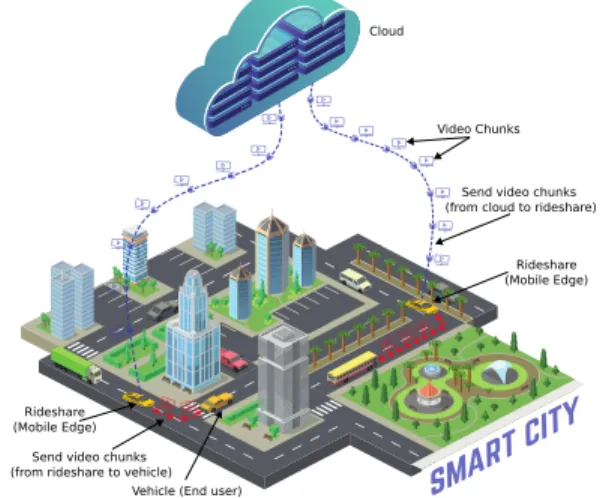HAL Id: hal-03163225
https://hal.archives-ouvertes.fr/hal-03163225
Submitted on 9 Mar 2021
HAL is a multi-disciplinary open access
archive for the deposit and dissemination of
sci-entific research documents, whether they are
pub-lished or not. The documents may come from
teaching and research institutions in France or
abroad, or from public or private research centers.
L’archive ouverte pluridisciplinaire HAL, est
destinée au dépôt et à la diffusion de documents
scientifiques de niveau recherche, publiés ou non,
émanant des établissements d’enseignement et de
recherche français ou étrangers, des laboratoires
publics ou privés.
Mobile vehicular edge computing architecture using
rideshare taxis as a mobile edge server
Mohammed Laroui, Boubakr Nour, Hassine Moungla, Hossam Afifi, Moussa
Cherif
To cite this version:
Mohammed Laroui, Boubakr Nour, Hassine Moungla, Hossam Afifi, Moussa Cherif. Mobile vehicular
edge computing architecture using rideshare taxis as a mobile edge server. CCNC 2020: IEEE 17th
Annual Consumer Communications & Networking Conference, Jan 2020, Las Vegas, United States.
pp.1-2, �10.1109/CCNC46108.2020.9045741�. �hal-03163225�
Mobile Vehicular Edge Computing Architecture
using Rideshare Taxis as a Mobile Edge Server
Mohammed Laroui
∗‡§, Boubakr Nour
¶, Hassine Moungla
‡§, Hossam Afifi
§, and Moussa Ali Cherif
∗∗EEDIS Laboratory, Computer Science Departement, Djillali Liabes University, Sidi Bel Abbes, Algeria ‡Universit´e de Paris, LIPADE, F-75006 Paris, France
§UMR 5157, CNRS, Institut Polytechnique de Paris, Telecom SudParis Saclay, France ¶School of Computer Science, Beijing Institute of Technology, Beijing, China
Emails: {mohammed.laroui,moussa.alicherif}@univ-sba.dz, {mohammed.laroui, hassine.moungla}@parisdescartes.fr, n.boubakr@bit.edu.cn, hossam.afifi@telecom-sudparis.eu
Abstract—We propose to utilize rideshare taxis as infras-tructure for both communication and computation. Rideshare overlays become hence Mobile Edge Nodes. End-users utilize near rideshare taxis as edge servers to receive video chunks for live video streaming. The set cover problem (SCP) is used to formulate the rideshare taxis coverage optimization inside the city. It provides the maximum number of rideshare taxis that cover end-users routes which guarantee the efficiency of com-munication services. Simulation results show that the proposed architecture dramatically enhances the quality of service and the overall communication performance in terms of execution time and energy consumption.
Index Terms—Vehicular Edge Computing, Rideshare Taxis, Energy Management.
I. INTRODUCTION
We propose an extended ’edge computing’ paradigm on top of a typical rideshare vehicular network. We design a fully distributed mobile vehicular edge architecture that takes rideshare taxis as infrastructure. This architecture has many of features that make it feasible and more scalable in real deployment including the geo-distribution [1], [2], low-latency communication [3], ubiquitous data caching and processing [4], [5]. The rideshare taxis coverage problem is formulated as a lineaire programming model where Set Cover Problem (SCP) [6] is used to maximize the coverage in order to maintain the service. We use a route prediction algorithm developed in [7], it predicts probable future positions (road crossings) for vehicles in city of Rome. In addition the cloud energy consumption (CEC) is measured with and without edge utilization in two different cases. Beside, the set cover problem is compared with Maximum Coverage Problem (MCP) [8] in terms of execution time.
II. MVEC: MOBILEVEHICULAREDGECOMPUTING
ARCHITECTURE
This section describes the proposed Mobile Vehicular Edge Computing (MVEC) architecture. Figure 1 illustrates a generic view of MVEC. In addition to cloud servers responsible for original data recovery and synchronization; we propose the
Mr. Laroui is corresponding author.
use of rideshare taxis as mobile infrastructure servers (mobile edge), tending to distribute the video chunks and providing a ubiquitous content distribution.
Cloud
Video Chunks
Rideshare (Mobile Edge)
Vehicle (End user) Send video chunks (from rideshare to vehicle)
Send video chunks (from cloud to rideshare)
Rideshare (Mobile Edge)
Fig. 1: MVEC architecture overview.
III. PROBLEMFORMULATION& PROPOSEDSOLUTION
The objective in this work is to maximize the shared path distance between the vehicle and the rideshare taxis with the minimum number of rideshare taxis to guarantee the efficiency of the service. Let S = {s1, s2, s3, ..., sn} a family of sets
represent the rideshare taxis routes, E = {e1, e2, e3, ..., em}
the representation of the vehicle route as a set of segments e inside the city whereS S = E, and H = {h1, h2, h3, ..., h4}
a set of handovers correspond to rideshare taxis route. The objective is to find a subset X of S such that S X = E and |X|, h(S X) are small as possible. The formulation of the problem based on SCP can be expressed as follow:
min n X i=1 xihi (1) Subject to: X {i|ej∈si} xi≥ 1 ∀ej ∈ E (2)
xi∈ {0, 1} , ∀i ∈ {1...n} (3)
• Complexity: The formulated problem is an adaptation of the SCP, which is an NP-complete. For this, the algorithm 1 use only a subset from the global set of rideshare taxis paths, this subset contain only the rideshare taxis that shared parts of the path with the vehicle which can reduce the complexity in terms of data processing, consequently reduce the execution time.
Algorithm 1: Rideshare Taxi Selection & Service Offering.
Input: RideshareTaxisRoutesList, VehiclesRoutesList Output: RideshareTaxisList
Find rideshare taxis that cover each vehicle route. for (i in VehiclesRoutesList) do
for (j in RideshareTaxisRoutesList) do if Intersect(i, j) ! = N ull) then
append j in RideshareTaxisList(i) end
end
return RideshareT axisList.
IV. PERFORMANCEEVALUATION
The performance of MVEC architecture has been evaluated using different scenarios in a simulated environment. We have used Cloud Report1 to simulate both rideshare and end-user communications with the cloud, and SUMO2 for urban mobility, as well as real tracking data of Rome city.
0 5 10 15 20 25 30 35 0 5 10 15 20 25 30 Energy (Kw) Time (Minutes) CEC During Cloud Utilization
CEC During Edge Utilization CEC For Only Cloud Utilization
* * * * * * * * * ** * * *** * Gain * * * * * (a) Route 1 0 5 10 15 20 25 30 35 0 5 10 15 20 25 30 Energy (Kw) Time (Minutes) CEC During Edge Utilization CEC During Cloud Utilization CEC For Only Cloud Utilization *
** * * * * * * ** * ** *** * Gain (b) Route 2
Fig. 2: CEC with/out Edge Servers.
Figure 2 displays the cloud energy consumption (CEC) with and without edge servers for two different routes. In Figure 2a we show that the energy consumption during cloud utilization and only cloud utilization is the same in the first 14 minutes because no coverage exists, after that, we can see that the energy is decreased when the edge server in the rideshare taxis is used and hence increases energy gain.
Similarly, in Figure 2b we show that the rideshare with high coverage leads to a decrease of cloud energy consumption and
1Cloud Report: www.github.com/thiagotts/CloudReports 2SUMO: www.sumo.dlr.de/docs/index.html 0 0.1 0.2 0.3 0.4 0.5 0.6 0.7 0.8 0.9 1 0 1000 2000 3000 4000 5000 6000 7000 8000 9000 10000
Execution Time (time unit)
Number of Taxis SCP Execution Time MCP Execution Time
Fig. 3: MCP & SCP Execution Time.
at the same time increase the gain of energy. Also we show that when no coverage exists, the energy consumption of cloud increase dramatically (red circles in Figures 2a and 2b) caused by the handover during the communication which leads to send a large number of requests to the cloud.
Figure 3 displays the execution time of the maximum coverage problem (MCP) and the set cover problem (SCP), we show that the execution time of the two algorithms is high when the number of rideshare taxi is increase, but the execution time of SCP is less than the MCP.
V. CONCLUSION& FUTUREWORK
In this poster, we have presented a distributed Mobile Vehicular Edge Computing (MVEC) architecture taking the benefits of rideshare taxis as infrastructure. With the increase of ride-sharing vehicles and their distribution in different cities, the proposed architecture can scale to cover big cities. The proposed architecture is promising to reshape the vehicular environment, and enhance both the communication and quality of service in large-scale scenarios. The next stage of our research will be deployment of the proposed architecture in a real scenario, and extending mobile rideshare taxis to buses and other public transportation networks. Thus, the selection will be based on advanced multi agent reinforcement learning algorithms that take into consideration traffic congestion, users and taxis itinerary.
REFERENCES
[1] R. Zhang et al., “A reliable and energy-efficient leader election algorithm for wireless body area networks,” in IEEE ICC, 2015, pp. 530–535. [2] H. Moungla et al., “Cost-effective reliability-and energy-based
intra-WBAN interference mitigation,” in IEEE GLOBECOM, 2014.
[3] H. Moungla et al., “Distributed interference management in medical wireless sensor networks,” in IEEE CCNC, 2016, pp. 151–155. [4] H. Khelifi et al., “Named data networking in vehicular ad hoc networks:
State-of-the-art and challenges,” IEEE Commun. Surveys Tuts., 2019. [5] M. Laroui et al., “Driving path stability in VANETs,” in IEEE
GLOBE-COM, 2018, pp. 1–6.
[6] R. M. Karp, “Reducibility among combinatorial problems,” in Complexity of computer computations. Springer, 1972, pp. 85–103.
[7] M. Laroui et al., “Energy Management For Electric Vehicles in Smart Cities: A Deep Learning Approach,” in IEEE IWCMC, 2019, pp. 1–6. [8] S. Khuller et al., “The budgeted maximum coverage problem,” Inf.

